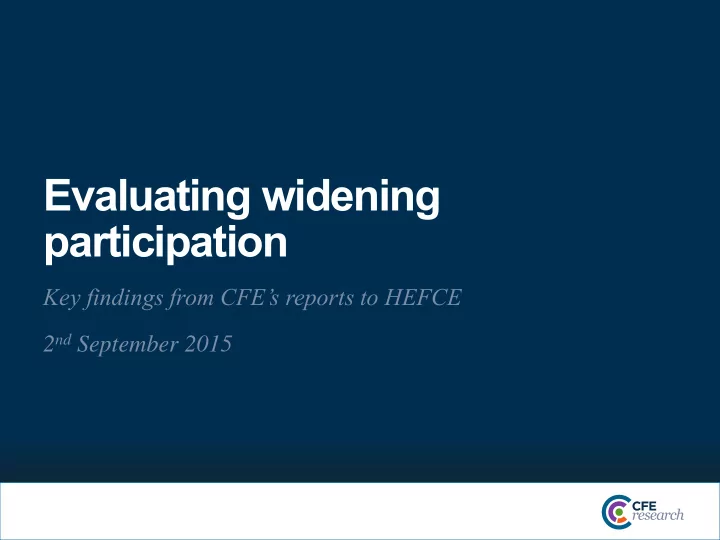

Evaluating widening participation Key findings from CFE’s reports to HEFCE 2 nd September 2015
About CFE Research An independent not- for-profit company specialising in providing research and evaluation services in the fields of education, the economy and wellbeing.
Working in partnership with... • Professor Liz Thomas • Economists from: • University of Sheffield • University of Sussex • University of Birmingham • London School of Economics
Two reports for HEFCE Report on the piloting of a more detailed data return
Two reports for HEFCE Report on the piloting of a more detailed data return In-depth study with case studies
What we did
Reviewed evidence
Review of evidence Drafted frameworks
Consulted with HE providers • Visits to 25 institutions • Interviews with key staff • 15 institutions also piloted the data return • Six case studies
Designed & piloted a more detailed data return
Key messages
The purpose of an evaluation framework • Accountability • Benchmarking What works • • Impact assessment Return on investment •
Different purposes require different approaches
Accountability • Data return most appropriate for this purpose • Any new data or changes need to be requested in advance of reporting periods... • ...with plenty of time to put in place data collection
Benchmarking UK Performance • Indicators meet this need • Measures should link back to the issue funding/activity is seeking to address • The role of measuring ‘distance travelled’
What works and impact • Need to improve attribution • Stronger evaluation methods with good comparison groups including RCTs • More appropriate for new or innovative approaches • Longitudinal tracking of students • Better use of secondary data • Supported by qualitative research
More evaluations with good comparison groups
More longitudinal tracking
Making better use of existing data For example, • National Pupil Database , HM Revenue & Customs Data Labs • • Small Business, Enterprise & Employment Act 2015
A role for qualitative research How does it work? • • Does it matter? • Is this intervention right for this group of people? Heinrich-Boll-Stiftung CC BY-SA 2.0
Return on investment Econometric analysis • of secondary data • Not all benefits of WP can or should be measured in financial terms Mattia Landoni CC BY-SA 2.0
Make findings accessible
Thank you Rachel Moreton rachel.moreton@cfe.org.uk 0116 229 3300 www.cfe.org.uk
Recommend
More recommend